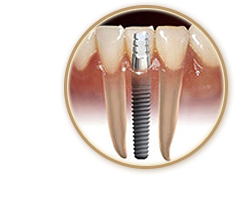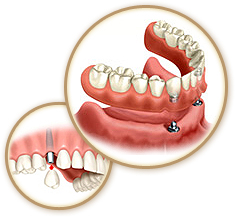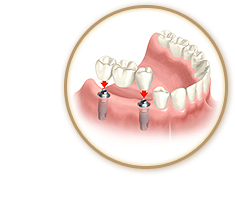 In case of a lack of teeth, it is the aim of every tooth replacement treatment to restore the natural conditions as accurately as possible. The fewer teeth are left, the more difficult it is to reach this aim. In case of a lack of teeth, it is the aim of every tooth replacement treatment to restore the natural conditions as accurately as possible. The fewer teeth are left, the more difficult it is to reach this aim.
Traditional tooth replacement methods cannot always provide a proper remedy to our existing problems. In these cases implantation may be the best solution! Dental implantology is a field in dentistry which combines oral surgery with tooth replacement methods to replace lack of teeth. The tooth replacement put on the implant will be as strong and useable as if the tooth replacement was made on natural teeth. Under implantation many people understand the implantation of teeth, although this is not at all the case. In the course of implantation most often a titanium screw (artificial root) is built into the jawbone, followed by the making of a superstructure faithfully mirroring the original anatomical characteristics of the teeth. The implants substitute the roots of the missing teeth. The dental implant is an” artificial root” made of biomaterial built into the jawbone for the purpose of wearing tooth replacements.  The dental implant is an artificial root made of biomaterial that is most frequently pure, unalloyed titanium, or as of late zircon-oxide ceramic which is built in the place of the tooth or teeth to be substituted. The dental implant is an artificial root made of biomaterial that is most frequently pure, unalloyed titanium, or as of late zircon-oxide ceramic which is built in the place of the tooth or teeth to be substituted.
It is surface-treated with different procedures so that the bone cells can “grow” onto the implant surface in as big an area as possible, allowing thereby the so called integration, the ossification of the implant to take place. The implants are generally screw-shaped with specially formed self-tapping threads and neck parts. With correct planning, surgical technology, regular control and care, as well as the patient’s conscious tooth replacement maintaining behaviour with respect to the implant and their own teeth, dental implants fulfil their function for life. Dental implantation is the latest method of replacing lack of teeth which is the least damaging for the other teeth. The installation of the implant(s) is done under sterile circumstances, with local anaesthetics. In the course of the operation the dentist prepares the given bone area for the reception of the implant. Following a small mucous membrane incision, we expose the bone surface, form the bone nest of the implant(s), and install the implant(s). The mucous membrane is thereafter closed with a few stitches above the implants in a tension-free way. Immediately after the surgery a control panorama X-ray image is made (without this implantations cannot be done in a responsible way). The stitches are removed in 7-10 days, and the implant(s) continue to heal protected under the mucous membrane.  The healing period takes approximately 3 months, this is the time needed for the bone cells to grow directly into the micro-pores on the implants’ surface. During this time the implant ossifies (the bone grows onto the implant and is fixed thereby). This bony accretion (the so called integration) provides the implants’ stability, as a result of which the implants can bear the chewing pressure in a permanent, damage-free way. During the healing period a temporary replacement can be worn. The healing period takes approximately 3 months, this is the time needed for the bone cells to grow directly into the micro-pores on the implants’ surface. During this time the implant ossifies (the bone grows onto the implant and is fixed thereby). This bony accretion (the so called integration) provides the implants’ stability, as a result of which the implants can bear the chewing pressure in a permanent, damage-free way. During the healing period a temporary replacement can be worn.
After the surgery the face may swell slightly, but there is no risk of more severe pain. Of course regular control is necessary. In the next step the tooth replacement implant is made. First the implants healing under the protection of the gum are freed. This is not an operation, only the so-called cap screw screwed into the implant has to be freed with the help of a small mucous membrane incision, and then the gum-forming superstructures are installed which form the gum in about 8-10 days. Afterwards an impression is taken, on the basis of which the previously planned tooth replacement, metal-free or traditional crown, bridge or removable denture is made by the technician within a short time. The replacements resemble the natural teeth very much, the difference is almost undetectable. The superstructure may be a covering crown, bridge, or a full plated removable denture.
With the installation of the tooth replacement implant into the mouth, the relationship between patient and dentist does not come to an end. One of the most important conditions of the long-term success of the tooth replacement implant is oral cleanliness and regular control by the dentist. Following the installation of the tooth replacement implant the patient has to come back for a control examination once a year in general.
What you have to know after the installation of the tooth replacement implant:
 Increased attention must be paid to oral hygiene. Depending on the teeth structure the use of special tools, like interdental brush, superfloss, dental floss is recommended. At the time of the delivery of the replacement, the dentist shows and explains the correct tooth cleaning technique. Increased attention must be paid to oral hygiene. Depending on the teeth structure the use of special tools, like interdental brush, superfloss, dental floss is recommended. At the time of the delivery of the replacement, the dentist shows and explains the correct tooth cleaning technique.
The long term success of dental prosthesis implantation depends largely on you as well. The responsibility of the dentist extends primarily as far as the making of the dental structure; afterwards mainly the patient is responsible for its maintenance. By maintaining proper oral hygiene the development of inflammation around the place of the implantation must be prevented, because this endangers the implant’s remaining in its place. Tooth implantation is the most up-to-date dental discipline, using the technology of the 21st century. Implantation systems developed over several decades coupled with adequate indication and oral hygiene ensure that today no patient has to worry about the danger of rejection. Furthermore the inimitable advantage of implantation technique is that with a fixed replacement it makes it possible to substitute removable tooth replacements, prosthesis in cases of a total lack of teeth. | 

 és Webmark
és Webmark